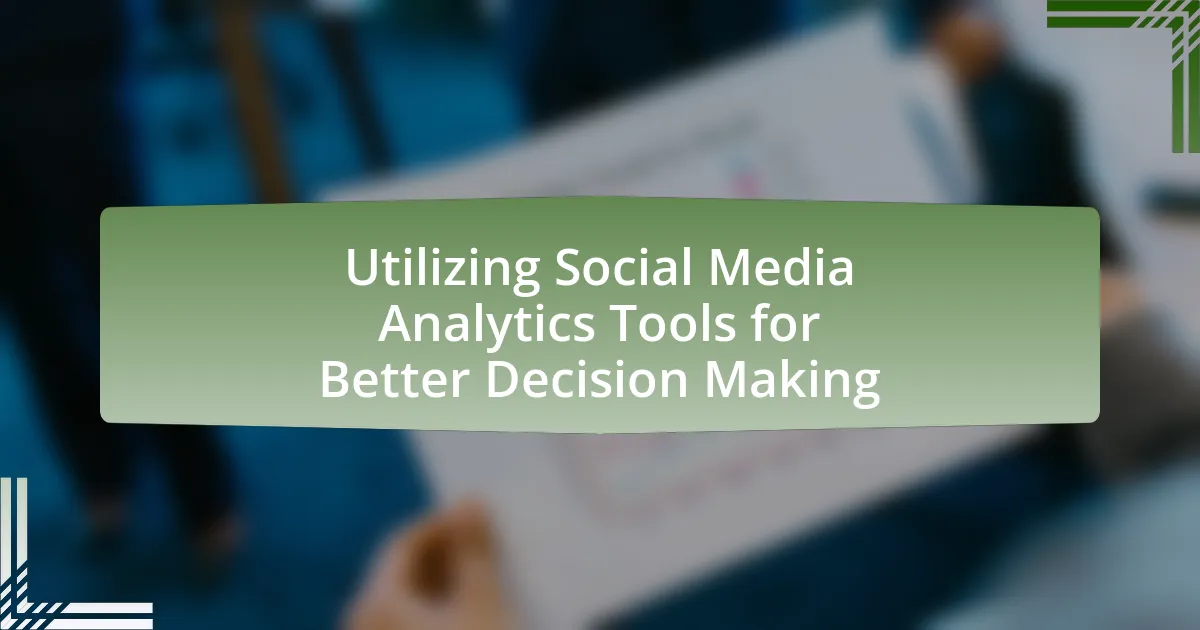Social media metrics are essential quantifiable data points that measure the performance and effectiveness of social media activities, including engagement rates, reach, impressions, and follower growth. These metrics provide valuable insights that inform business strategies, enhance marketing efforts, and drive better results. The article outlines the specific metrics businesses should focus on, such as engagement rates and conversion rates, and discusses how these metrics influence decision-making processes. Additionally, it highlights the importance of tracking social media metrics, the tools available for analysis, common mistakes to avoid, and best practices for effective metrics analysis.

What are Social Media Metrics and Why are They Important?
Social media metrics are quantifiable data points that measure the performance and effectiveness of social media activities. These metrics, such as engagement rates, reach, impressions, and follower growth, are crucial for understanding audience behavior and optimizing content strategies. For instance, a study by Hootsuite found that brands that actively track social media metrics can increase their engagement by up to 30%. This demonstrates that analyzing these metrics allows businesses to make informed decisions, enhance their marketing efforts, and ultimately drive better results.
How do Social Media Metrics Impact Business Strategy?
Social media metrics significantly impact business strategy by providing data-driven insights that inform decision-making. These metrics, such as engagement rates, reach, and conversion rates, allow businesses to assess the effectiveness of their marketing efforts and understand customer preferences. For instance, a study by Hootsuite found that companies using social media analytics are 23 times more likely to acquire customers than those that do not. By analyzing these metrics, businesses can refine their content strategies, target specific demographics more effectively, and allocate resources efficiently, ultimately leading to improved ROI and competitive advantage.
What specific metrics should businesses focus on?
Businesses should focus on engagement rate, reach, conversion rate, and follower growth as specific metrics. Engagement rate measures the level of interaction (likes, comments, shares) relative to total followers, indicating content effectiveness. Reach quantifies the number of unique users who see content, essential for understanding audience exposure. Conversion rate tracks the percentage of users completing desired actions (e.g., purchases, sign-ups) from social media, reflecting campaign success. Follower growth shows the increase in audience size over time, essential for assessing brand awareness and market penetration. These metrics collectively provide a comprehensive view of social media performance and inform strategic decisions.
How can metrics influence decision-making processes?
Metrics influence decision-making processes by providing quantifiable data that guides strategic choices. For instance, social media engagement metrics, such as likes, shares, and comments, allow organizations to assess audience preferences and tailor content accordingly. Research indicates that companies utilizing data-driven decision-making are 5-6% more productive and profitable than their competitors, highlighting the effectiveness of metrics in shaping business strategies. By analyzing these metrics, decision-makers can identify trends, allocate resources efficiently, and enhance overall performance.
What Types of Social Media Metrics Exist?
Social media metrics can be categorized into several types, including engagement metrics, reach metrics, conversion metrics, and audience metrics. Engagement metrics, such as likes, shares, and comments, measure how users interact with content. Reach metrics, including impressions and unique visitors, assess how many people see the content. Conversion metrics track actions taken as a result of social media efforts, such as clicks to a website or sign-ups. Audience metrics provide insights into the demographics and behaviors of followers, helping to tailor content effectively. These categories are essential for evaluating the effectiveness of social media strategies and optimizing future campaigns.
What are Engagement Metrics and why do they matter?
Engagement metrics are quantitative measures that assess how users interact with content on social media platforms, including likes, shares, comments, and overall reach. These metrics matter because they provide insights into audience behavior, indicating the effectiveness of content strategies and helping brands understand what resonates with their audience. For instance, a study by HubSpot found that posts with higher engagement rates lead to increased brand awareness and customer loyalty, demonstrating the direct correlation between engagement metrics and business success.
How do Reach and Impressions differ in social media metrics?
Reach and impressions are distinct metrics in social media analytics. Reach refers to the total number of unique users who have seen a post, indicating the breadth of audience exposure. In contrast, impressions measure the total number of times a post has been displayed, regardless of whether it was clicked or not, reflecting the frequency of views. For example, if a post is shown to the same user multiple times, each display counts as an impression, but only one counts towards reach. This differentiation is crucial for understanding audience engagement and content visibility, as reach highlights the unique audience size while impressions provide insight into overall content exposure.
What are the Key Benefits of Tracking Social Media Metrics?
Tracking social media metrics provides essential insights that enhance marketing strategies and improve audience engagement. By analyzing metrics such as engagement rates, reach, and conversion rates, businesses can identify what content resonates with their audience, allowing for data-driven decisions. For instance, a study by HubSpot found that companies that actively track social media metrics experience a 30% increase in engagement and a 20% increase in lead generation. This demonstrates that effective tracking leads to improved performance and better alignment with audience preferences.
How can tracking metrics improve audience understanding?
Tracking metrics enhances audience understanding by providing quantitative data on user behavior and preferences. This data allows marketers to identify trends, engagement levels, and content effectiveness, leading to more informed decisions. For instance, a study by HubSpot found that businesses that utilize analytics are 5 times more likely to make data-driven decisions, which directly correlates with improved audience targeting and content relevance. By analyzing metrics such as click-through rates, engagement rates, and demographic information, organizations can tailor their strategies to better meet the needs and interests of their audience, ultimately fostering stronger connections and increasing overall satisfaction.
What role do metrics play in measuring campaign success?
Metrics are essential in measuring campaign success as they provide quantifiable data that reflects performance and effectiveness. By analyzing metrics such as engagement rates, conversion rates, and return on investment (ROI), marketers can assess how well a campaign meets its objectives. For instance, a study by HubSpot found that companies that actively track their marketing metrics are 1.5 times more likely to make informed decisions that lead to successful outcomes. This data-driven approach enables continuous improvement and optimization of marketing strategies, ensuring resources are allocated effectively for maximum impact.
How Can You Effectively Track Social Media Metrics?
To effectively track social media metrics, utilize analytics tools that provide insights into engagement, reach, and audience demographics. Tools like Google Analytics, Hootsuite, and Sprout Social allow users to monitor key performance indicators (KPIs) such as likes, shares, comments, and follower growth. According to a report by HubSpot, 70% of marketers say that measuring social media ROI is crucial for their strategy, highlighting the importance of tracking these metrics for informed decision-making.
What Tools are Available for Analyzing Social Media Metrics?
Several tools are available for analyzing social media metrics, including Hootsuite, Sprout Social, Buffer, and Google Analytics. Hootsuite provides comprehensive analytics for multiple social media platforms, allowing users to track engagement, reach, and audience demographics. Sprout Social offers in-depth reporting features and social listening capabilities, enabling brands to understand audience sentiment and trends. Buffer focuses on scheduling and performance analytics, helping users optimize their posting strategies based on engagement data. Google Analytics can track social media traffic to websites, providing insights into user behavior and conversion rates. These tools are widely used in the industry, demonstrating their effectiveness in measuring and analyzing social media performance.
Which tools provide the most comprehensive insights?
Tools that provide the most comprehensive insights into social media metrics include Hootsuite, Sprout Social, and Google Analytics. Hootsuite offers extensive analytics features that track engagement, reach, and audience demographics across multiple platforms, allowing users to measure the effectiveness of their social media strategies. Sprout Social provides in-depth reporting tools that analyze content performance and audience interaction, enabling businesses to refine their social media tactics. Google Analytics integrates social media data with website performance metrics, offering a holistic view of user behavior and conversion rates. These tools are widely recognized for their ability to deliver actionable insights, supported by user testimonials and industry reviews highlighting their effectiveness in optimizing social media campaigns.
How do these tools integrate with existing marketing platforms?
These tools integrate with existing marketing platforms through APIs and data connectors that facilitate seamless data exchange. For instance, many social media analytics tools can connect directly to platforms like HubSpot or Salesforce, allowing marketers to pull in social media performance data and analyze it alongside other marketing metrics. This integration enables a comprehensive view of campaign effectiveness and customer engagement, enhancing decision-making processes. Additionally, tools such as Google Analytics can track social media traffic and conversions, providing concrete insights into how social media efforts contribute to overall marketing goals.
What Common Mistakes Should You Avoid When Analyzing Metrics?
Common mistakes to avoid when analyzing metrics include ignoring context, relying solely on vanity metrics, and failing to segment data. Ignoring context can lead to misinterpretation of data trends, as metrics may vary significantly based on external factors such as seasonality or market changes. Relying solely on vanity metrics, like total likes or followers, can provide a false sense of success without reflecting actual engagement or conversion rates. Additionally, failing to segment data can obscure insights, as different audience segments may behave differently, leading to generalized conclusions that do not apply universally. These mistakes can hinder effective decision-making and strategy development in social media analysis.
How can misinterpretation of data lead to poor decisions?
Misinterpretation of data can lead to poor decisions by causing stakeholders to draw incorrect conclusions from social media metrics. For instance, if a company misreads engagement rates as a sign of overall brand health, it may overlook declining sales figures, resulting in misguided marketing strategies. A study by the Harvard Business Review found that 70% of data-driven decisions fail due to misinterpretation, highlighting the critical need for accurate data analysis. This misalignment between perceived and actual performance can lead to wasted resources and missed opportunities, ultimately harming the organization’s objectives.
What are the pitfalls of focusing on vanity metrics?
Focusing on vanity metrics can lead to misguided decision-making and a lack of meaningful insights. Vanity metrics, such as likes and follower counts, do not necessarily correlate with actual engagement or conversion rates, which are critical for assessing the effectiveness of social media strategies. For instance, a study by HubSpot found that businesses prioritizing engagement metrics over vanity metrics saw a 30% increase in lead generation. This indicates that reliance on superficial numbers can obscure the true performance of marketing efforts, ultimately hindering growth and ROI.
What Best Practices Should You Follow for Social Media Metrics Analysis?
To effectively analyze social media metrics, you should establish clear objectives aligned with your overall marketing goals. This practice ensures that the metrics you track are relevant and actionable. For instance, if your goal is to increase brand awareness, focus on metrics such as reach and impressions. Additionally, regularly review and adjust your metrics based on performance trends and changes in strategy, as this allows for continuous improvement. According to a study by HubSpot, companies that regularly analyze their social media metrics see a 30% increase in engagement over those that do not. This demonstrates the importance of not only tracking metrics but also adapting your approach based on the insights gained.




